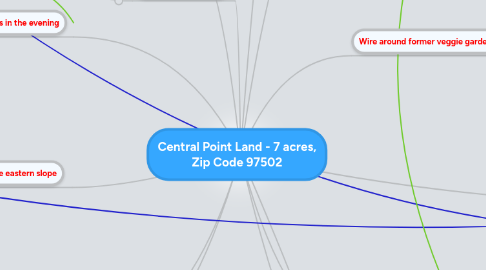
1. The house is on the eastern slope
1.1. Gets warm in the morning
1.2. Holds heat all day
1.2.1. Hot in hot summer!
1.2.1.1. Plant grape arbors around the house
1.2.1.1.1. Leaves shade in summer
1.2.1.1.2. Bare vines in winter let the sun through!
1.2.1.1.3. Grapes!
1.2.1.1.4. Cool design opportunities... viva Vertecology!
1.2.1.2. Work in a solar chimney that can be opened in summer and closed in winter
1.2.2. Warm in the cold winter
2. Wild Turkeys
2.1. Active in the early AM
3. War between the US and the indigenous people 1850's to 1860's
3.1. Logging, clearcutting?
3.1.1. Second generation forest
4. Lots of mosquitoes in the evening
5. Frogs audible at night
5.1. Water somewhere nearby
5.1.1. Introduce mosquito fish
6. Well depth: 6 feet
6.1. Very high water table
7. How to read this mindmap - what the colors mean
7.1. Direct Observation
7.2. Conclusion from observation
7.3. Research
7.4. Solutions and Opportunities!
8. A few pines around
9. Gambel Oaks
9.1. Gambels dominate the landscape on the eastern hillside and hilltop
9.1.1. Strengthen the ecosystem by increasing tree diversity... and stack functions by planting...
9.1.1.1. Fruit trees!
9.1.1.1.1. Fruits humans love!
9.1.1.1.2. Fruits deer love too, to distract from the veggie garden!
9.1.1.1.3. Fruits birds love too, to distract them from the veggie garden!
9.2. Fruit
9.2.1. Attraction?
9.2.2. Edible?
9.3. Woodpeckers!
9.4. Dropped leaves
9.4.1. Last week: no rain for weeks, 100 degrees F, and under 2-6 inches of leaves, the soil is black and moist!
9.4.1.1. Add compost to wet areas to accelerate decay and accelerate ecosystem maturity
9.4.1.2. Introduce mycelium to the wet areas to accelerate the ecosystem maturity
9.4.1.3. Dig out chinampas and swales at the hill bottom to retain more water on the land
10. Lots of songbirds
10.1. Very active from sunrise mid morning
10.2. Quieter in the afternoon
10.3. Quieter on rainy days
10.4. Fill the existing birdfeeders with seeds that can grow and bring more plant diversity
11. Tall grasses at the bottom of the hill and in the valley
11.1. Pioneer species
11.2. Some of the grass has been mowed to less than 6 inches
11.2.1. In low grassland: no rain for weeks, 100 degrees F, and the soil is dust!
11.2.1.1. Mowing the grass = permanent, dry dusty soil. Mowing = short term elimination of the fire hazard but long term stunting of evolutionary succession and permanent fire worry.
11.2.1.1.1. Introduce mowing alternatives...
